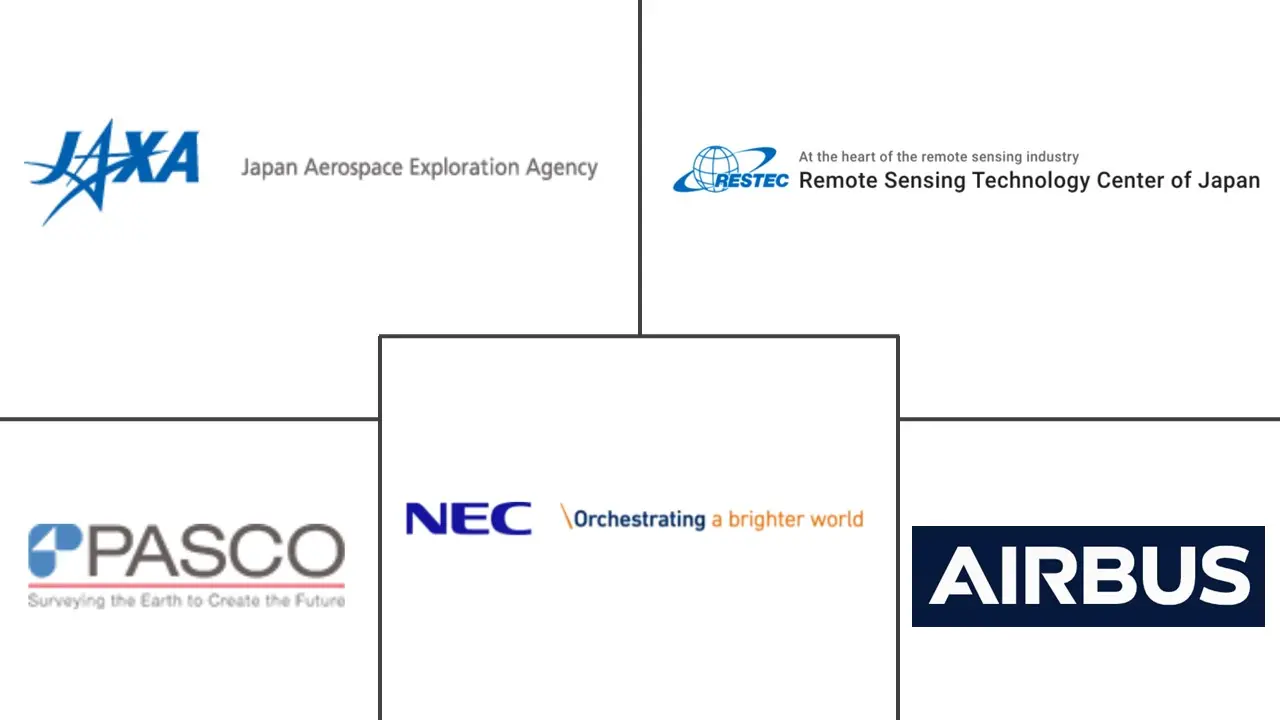Japan Satellite-based Earth Observation Market Size and Share
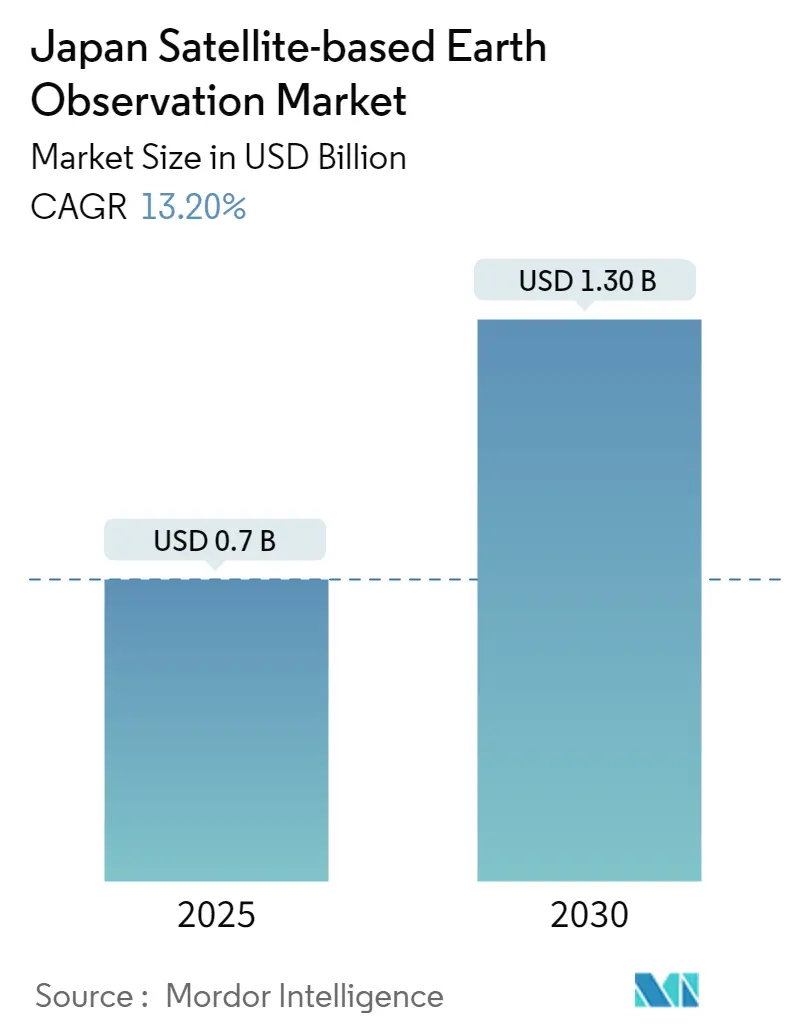
Japan Satellite-based Earth Observation Market Analysis by Mordor Intelligence
The Japan Satellite-based Earth Observation Market size is estimated at USD 0.70 billion in 2025, and is expected to reach USD 1.30 billion by 2030, at a CAGR of 13.2% during the forecast period (2025-2030).
The continuous advancement of satellite technology, including higher-resolution imaging capabilities, improved data processing algorithms, and enhanced data transmission, is expected to drive the Earth observation market in Japan. These advancements enable better data acquisition, analysis, and interpretation for various applications.
- Satellite-based Earth observation is essential for Japan's disaster management, environmental monitoring, agriculture, infrastructure planning, fisheries management, climate research, national security, and scientific endeavors. By leveraging satellite technology and data, Japan can make informed decisions, enhance preparedness, and contribute to sustainable development.
- Government initiatives and investments primarily drive the market in Japan. The Japanese government has actively promoted the development of the space industry, recognizing the importance of satellite-based Earth observation for addressing critical challenges. Through policies, funding, and collaboration with public and private entities, the government has created a favorable ecosystem for market growth.
- One of the key drivers of the market is the need for effective disaster management. Japan is prone to natural disasters, including earthquakes, tsunamis, typhoons, and volcanic eruptions. Satellite-based Earth observation is crucial in monitoring and assessing these events, providing real-time data, early warning systems, and post-disaster analysis. The demand for accurate and timely information to enhance disaster preparedness and response drives the market in this segment.
- Another significant driver is the growing focus on environmental monitoring and climate change. Japan, as an island nation with diverse ecosystems, recognizes the importance of monitoring environmental parameters such as deforestation, urbanization, pollution, and the impact of climate change. Satellite-based Earth observation provides valuable data and insights for understanding and managing these environmental challenges. The increasing awareness of sustainability and the need for informed decision-making propel the demand for Earth observation solutions in this domain.
- Despite the government's support, budget constraints can limit the scale and pace of investment in satellite-based Earth observation initiatives. Allocating funds for satellite launches, infrastructure development, data processing, and research and development can be challenging, mainly when competing with other national priorities.
Japan Satellite-based Earth Observation Market Trends and Insights
Government Initiatives and Investments to Drive the Market Growth
- The Japan satellite-based earth observation market is experiencing significant growth, primarily driven by the Japanese government's active involvement and investments. The government's initiatives and funding have played a crucial role in promoting the development and utilization of satellite-based Earth observation technologies across various sectors.
- The Japanese government has allocated substantial funding to support research, development, and implementation of satellite-based Earth observation projects. Funding programs such as grants, subsidies, and tax incentives encourage public and private entities to invest in Earth observation initiatives. These financial resources facilitate the development of new technologies, data acquisition systems, and data processing infrastructure.
- Additionally, the government actively promotes collaborations between public and private entities to drive the growth of the satellite-based Earth observation market. Partnerships between government agencies, research institutions, and private companies foster innovation, knowledge sharing, and resource pooling. These partnerships facilitate the development of cutting-edge technologies, data analysis methods, and commercial applications.
- Further, the government, particularly the Ministry of Internal Affairs and Communications, has encouraged the establishment of satellite offices throughout Japan. These offices are hubs for satellite-related activities, including data acquisition, processing, and analysis. By establishing satellite offices in rural areas as part of a regional revitalization strategy, the government aims to extend the benefits of Earth observation technologies beyond urban centers and promote equitable access to satellite-based data and services.
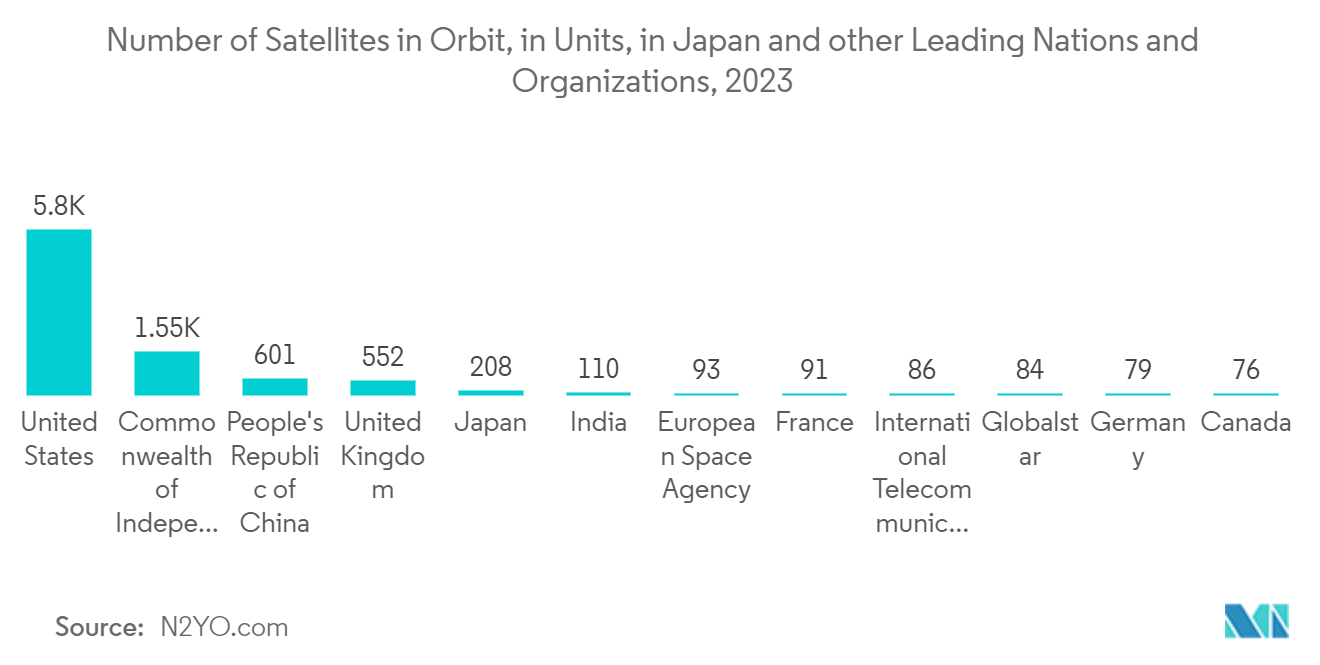
Urban Development and Cultural Heritage Segment to Hold a Significant Market Share
- As the country experiences rapid urbanization and grapples with the need to balance development with the preservation of cultural assets, satellite imagery and data play a crucial role in monitoring, planning, and managing urban areas.
- Japan's urban areas are expanding rapidly, leading to increased demand for satellite-based Earth observation to support urban planning and infrastructure development. Satellite imagery provides valuable insights into urban growth patterns, land-use changes, and population dynamics. It aids in identifying suitable areas for residential, commercial, and industrial development, as well as planning transportation networks, utilities, and public services. The accurate and up-to-date data obtained through satellite observation assists urban planners in making informed decisions for sustainable and efficient urban development.
- Japan boasts a rich cultural heritage with numerous historical sites, archaeological remains, and traditional landscapes. Satellite-based Earth observation is vital in documenting and preserving cultural heritage by providing high-resolution imagery, elevation data, and mapping capabilities.
- Satellite imagery helps identify, document, and monitor heritage structures, archaeological sites, and traditional landscapes. This information supports heritage preservation planning, restoration projects, and the sustainable management of cultural assets. It also aids in monitoring and preventing unauthorized development or encroachment on heritage sites.
- The expansion of residential areas necessitates the development of supporting infrastructure such as transportation networks, utilities, and public services. Satellite-based Earth observation enables the monitoring and assessing infrastructure systems, including roads, bridges, railways, and utilities. It provides valuable data for infrastructure planning, maintenance, and disaster management, ensuring urban areas' efficient and sustainable development.
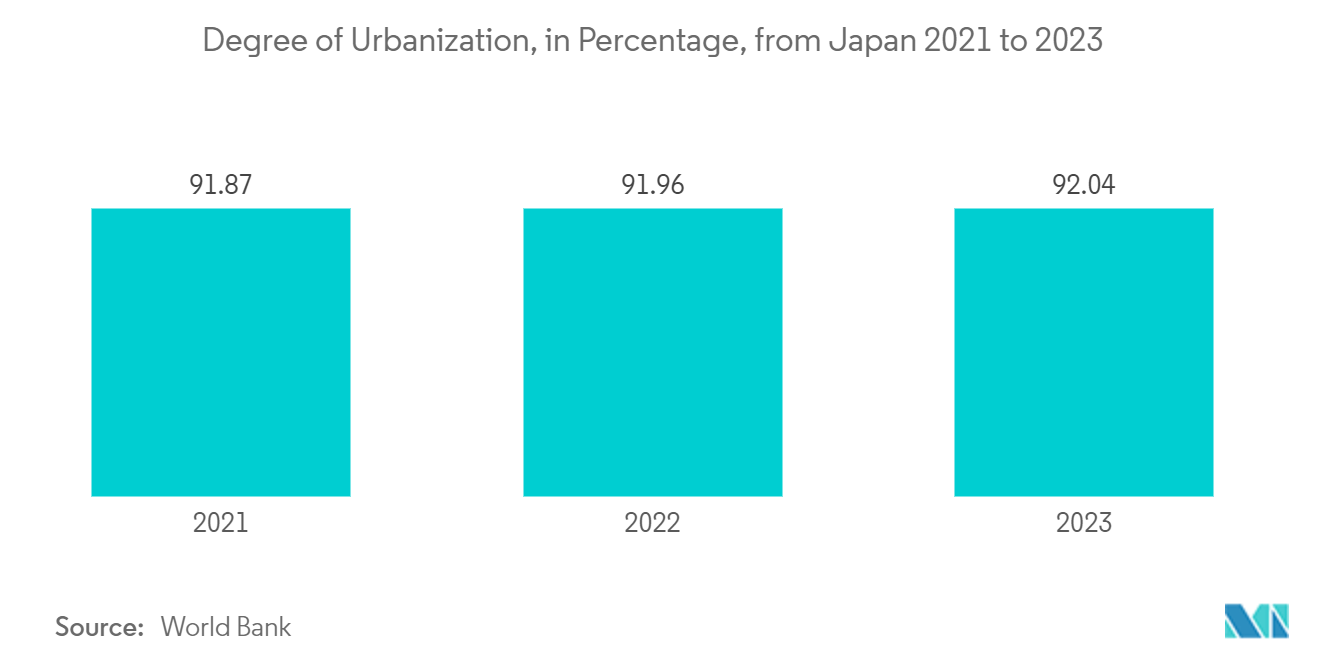
Competitive Landscape
The Japan satellite-based earth observation market is relatively fragmented, with multiple players operating in the industry. In Japan, various government agencies, research institutions, private companies, and international collaborations contribute to developing and utilizing satellite-based Earth observation technologies. The market fragmentation can be attributed to several factors, including the evolving nature of satellite technology, the diversity of applications, and different niche markets within the broader Earth observation industry. A few of the prominent market players include the Japan Aerospace Exploration Agency (JAXA), PASCO Corporation, Airbus SE, NEC Corporation, and the Remote Sensing Technology Center of Japan (RESTEC).
In February 2023, Axelspace and New Space Intelligence entered into a strategic relationship. Japan-based New Space Intelligence offers modern satellite image analysis services. Through this relationship, the companies will collaborate to advance the growth of satellite data usage. The businesses will work together primarily to create innovative applications employing satellite imagery and broaden service offerings to international markets.
In January 2023, Skyloom and Space Compass, a joint venture between NTT and SKY Perfect JSAT, declared that the firms had finalized their collaboration, including the launch of SkyCompass-1, their first geostationary-based (GEO) optical data relay node over Asia-Pacific, by Q4 2024. The team's modern networking and communication solutions will cater to the rapidly expanding Earth-Observation (EO) market for real-time, high-capacity, direct-to-cloud data transfer. The first stage of their collaboration is SkyCompass-1, and over the following few years, the firms hope to grow their GEO constellation to offer more capacity and worldwide coverage.
Japan Satellite-based Earth Observation Industry Leaders
-
Japan Aerospace Exploration Agency (JAXA)
-
PASCO Corporation
-
Airbus SE
-
NEC Corporation
-
Remote Sensing Technology Center of Japan (RESTEC)
- *Disclaimer: Major Players sorted in no particular order
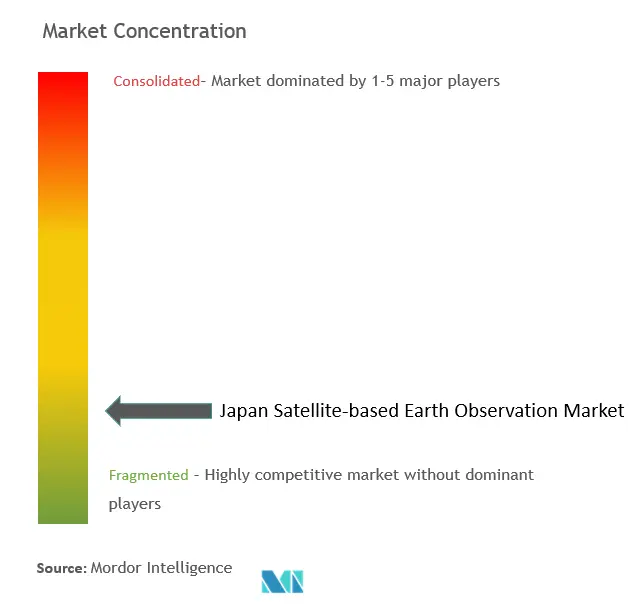
Recent Industry Developments
- January 2023: The European Union and Japan established a stronger connection in space research by collaborating to exchange Earth observation data. The European Commission approved granting Japan's Ministry of Economy, Trade, and Industry access to Copernicus data and services-the Earth observation component of the EU Space Programme. In exchange, the European Commission will receive unrestricted access to data from Japan's non-commercial Earth observation satellites.
- December 2022: Synspective and Topcon Positioning Asia (TPA), the regional office of Topcon in Asia, established a partnership to provide satellite data solution services. Topcon, a firm that includes surveying and construction services, and Synspective, a startup that offers synthetic aperture radar (SAR) satellite data and solutions, will work together to create new opportunities and innovate in the satellite data sector in Japan and worldwide.
Japan Satellite-based Earth Observation Market Report Scope
Satellite-based earth observation is done with the help of satellites orbiting around the planet to view and identify environmental changes, map making, etc. Satellite-based earth observation technology captures and stores information from satellites relating to the physical, biological, and chemical compositions of the earth for monitoring, surveillance, and decision-making in various verticals, such as defense and intelligence, infrastructure and engineering, natural resource management, energy and power, and disaster management.
The Japan satellite-based earth observation market is segmented by type (earth observation data, value-added services), satellite orbit (low earth orbit, medium earth orbit, geostationary orbit), and end-use (urban development and cultural heritage, agriculture, climate services, energy and raw materials, infrastructure). The market sizes and forecasts are provided in terms of value (USD billion) for all the above segments.
| Earth Observation Data |
| Value Added Services |
| Low Earth Orbit |
| Medium Earth Orbit |
| Geostationary Orbit |
| Urban Development and Cultural Heritage |
| Agriculture |
| Climate Services |
| Energy and Raw Materials |
| Infrastructure |
| Others |
| By Type | Earth Observation Data |
| Value Added Services | |
| By Satellite Orbit | Low Earth Orbit |
| Medium Earth Orbit | |
| Geostationary Orbit | |
| By End-use | Urban Development and Cultural Heritage |
| Agriculture | |
| Climate Services | |
| Energy and Raw Materials | |
| Infrastructure | |
| Others |
Key Questions Answered in the Report
How big is the Japan Satellite-based Earth Observation Market?
The Japan Satellite-based Earth Observation Market size is expected to reach USD 0.70 billion in 2025 and grow at a CAGR of 13.20% to reach USD 1.30 billion by 2030.
What is the current Japan Satellite-based Earth Observation Market size?
In 2025, the Japan Satellite-based Earth Observation Market size is expected to reach USD 0.70 billion.
Who are the key players in Japan Satellite-based Earth Observation Market?
Japan Aerospace Exploration Agency (JAXA), PASCO Corporation, Airbus SE, NEC Corporation and Remote Sensing Technology Center of Japan (RESTEC) are the major companies operating in the Japan Satellite-based Earth Observation Market.
What years does this Japan Satellite-based Earth Observation Market cover, and what was the market size in 2024?
In 2024, the Japan Satellite-based Earth Observation Market size was estimated at USD 0.61 billion. The report covers the Japan Satellite-based Earth Observation Market historical market size for years: 2019, 2020, 2021, 2022, 2023 and 2024. The report also forecasts the Japan Satellite-based Earth Observation Market size for years: 2025, 2026, 2027, 2028, 2029 and 2030.
Page last updated on:
Japan Satellite-based Earth Observation Market Report
Statistics for the 2025 Japan Satellite-based Earth Observation market share, size and revenue growth rate, created by Mordor Intelligence™ Industry Reports. Japan Satellite-based Earth Observation analysis includes a market forecast outlook for 2025 to 2030 and historical overview. Get a sample of this industry analysis as a free report PDF download.
